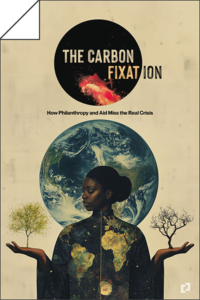The Carbon Fixation:
How Philanthropy and Aid Miss the Real Crisis
This report challenges the dominant approaches in climate philanthropy and climate aid, which are heavily focused on technological solutions and market-driven strategies that prioritize economic growth and measurable outcomes. While these models aim to reduce carbon emissions, they often ignore the root causes of climate change, such as global inequality, resource extraction, and overconsumption, all while reflecting Northern-centric interests. By critiquing this technocratic, top-down approach, the report advocates for a shift toward more inclusive, community-driven solutions that prioritize justice, equity, and long-term sustainability. It calls for a reimagining of climate finance to address both environmental and social justice in the fight against the climate crisis.

In recent years, climate philanthropy and climate aid have been presented as critical tools in the global effort to mitigate climate change. However, behind their well-intentioned façades, both systems reveal deep structural issues that perpetuate the economic paradigms responsible for the crisis. Central to these approaches is the persistent belief in economic growth as compatible with climate action. The global flow of funds, largely driven by Northern donors and economic interests, often reflects this belief in green growth, despite evidence to the contrary.
In 2022, climate philanthropy directed an estimated $7.8 billion to technocratic solutions such as clean energy and industrial decarbonization. These efforts are often lauded for their measurable impact—such as carbon reduction—but they fail to address the complex systemic drivers of climate breakdown, including resource extraction, economic inequality, and overconsumption. While these projects do succeed in cutting emissions on a surface level, they are aligned with maintaining the current capitalist economic model rather than shifting to a more sustainable system. Philanthropy continues to overlook alternative solutions such as degrowth or bioregionalism, which challenge the assumption that we can grow our way out of the climate crisis.
Similarly, climate aid, which is largely governed by OECD countries, allocated billions to carbon offset schemes in the Global South. These schemes, while promoting the idea of reducing emissions, often fail to address the real needs of the most climate-vulnerable regions. For example, much of the aid in 2021 was focused on carbon offsets and market-based solutions, with approximately $100 billion pledged by wealthy nations to help developing countries cope with climate change. However, a significant portion of this was recycled from existing development funds, and the actual new resources provided fell far short of the intended targets. Furthermore, the focus on offsetting emissions allows wealthy nations to continue polluting, while using the South as a carbon sink, effectively maintaining global inequalities under the guise of climate aid.
Both climate philanthropy and climate aid are built on the false promise of green growth—the idea that economies can continue expanding while reducing emissions. Despite technological advancements, global emissions rose by 1.6% in 2022, highlighting the limitations of this model. The notion that growth and sustainability can coexist ignores the fundamental contradiction between capitalist expansion and the planet’s finite resources. The belief that net-zero emissions can be achieved under current conditions is increasingly seen as an illusion, as the underlying drivers of climate destruction—consumption, extraction, and inequality—remain unaddressed.
A new paradigm for climate finance is urgently needed. Both philanthropy and aid must move beyond short-term, measurable fixes and embrace holistic, community-driven solutions that prioritize justice, equity, over growth. Approaches like degrowth, bioregionalism, and local resilience-building offer more sustainable and just alternatives – gesturing to a viable transition to post capitalist realities. By addressing the deeper systemic issues at play, climate finance can finally begin to create the long-term, transformative change needed to truly combat the climate crisis.

